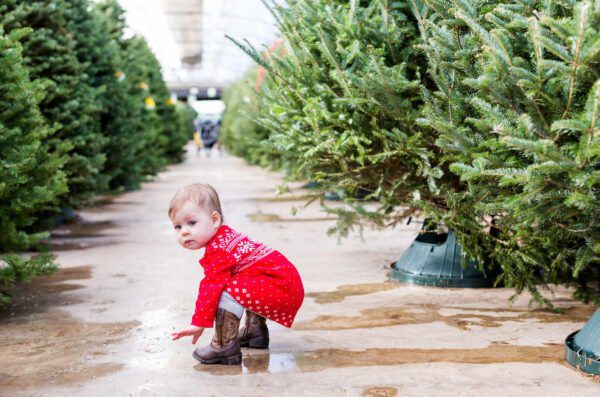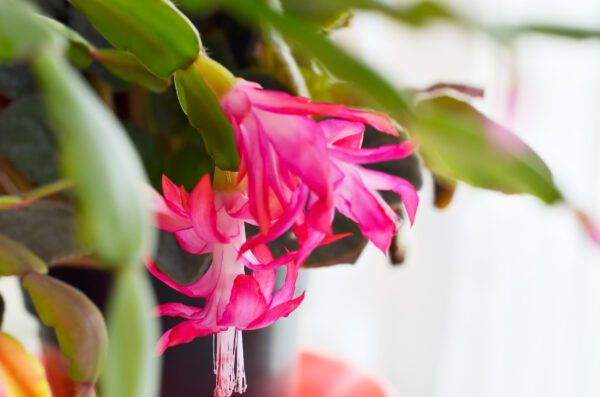How to Care For Christmas Trees and Holiday Plants
It’s beginning to look a lot like Christmas! If one of your traditions is to decorate a fresh-cut tree, read these tips before bringing it inside. With the cost of fresh-cut Christmas trees on the rise, you’ll want to take steps to ensure it stays looking great for all your celebrations! ‘Tis the season for poinsettias and Christmas cacti, too. Read on to learn how to keep them looking fresh & festive!
Reminder: Freshly cut Christmas trees are farmed specifically for their purpose and help support local agriculture. Plus, while the trees are growing they are contributing oxygen and scrubbing CO2 from the air!

Caring for Christmas Trees
- Be sure to purchase your tree from a reputable nursery, or cut your own. If there are needles on the floor, shop elsewhere.
- Leave your tree in the garage for a day or two before bringing it inside to allow it time to adjust to the warmer temperatures. To keep unwanted pests out of your home, you can spray the tree with our all-natural Yard Guard to prevent biting insects, mold, and fungus, too! Mix 1/4 cup Yard Guard with water in a 1 QT sprayer and mist the tree with the solution. Safe for kids and pets alike!
- Saw off at least an inch or two from the trunk before placing it in water to allow the tree to absorb water through the pores (they can usually do this for you at the tree lot when you purchase your tree!)
- Water your tree regularly, being sure not to let the water level go below the tree’s base. A fresh-cut tree can soak up a gallon of water in 24 hours!
- After the holiday season, you can keep the tree in your yard as a safe haven for birds and small mammals, to protect them from predators. Or, remove the branches and use them as winter mulch over bulbs and perennials. Layer the boughs over the plants and soil to keep the soil temperature consistent and to protect them from winter damage.
Caring for Poinsettias
Poinsettias are a tropical plant, so be sure to protect them from the cold after you purchase them – don’t leave them in a cold car while you run other errands!
Where to Place a Poinsettia
Poinsettias require bright, indirect light during the day, so place them near a well-lit window, but do not let it touch the cold glass. East-facing windows are best. Be sure to keep it out of direct sun, which could fade or burn the leaves. Avoid spots near heating vents and doors. Excess heat can dry out the plants and cold drafts will cause leaves to drop.
Poinsettia Watering Tips
Keep the soil moist but be careful not to overwater. Only water when the top inch or two of soil feels dry to the touch. Be sure to remove any foil that might gather water. Letting the plant sit in water can cause root rot. Placing the plants on a tray filled with pebbles and water will increase the relative humidity (remember – they’re a tropical plant) while protecting the roots.

Christmas Cactus Indoor Care

Christmas Cacti are not like your typical cactus, they’re actually a tropical succulent species and prefer high humidity and indirect sunlight. You’ll need to water them more often than other succulents, but they still require minimal care. They typically bloom from November – February, making them a cheerful addition to your home in winter. (Although, customers who have sprayed their Christmas cactus with Houseplant Hero have reported getting several more blooms throughout the year!)
Where to Place a Christmas Cactus
Like poinsettias, Christmas Cacti require bright, indirect light and prefer a more humid environment. A bright bathroom or kitchen can be an ideal spot.
Christmas Cactus Watering Tips
Plan to water your Christmas cactus every 2 – 3 weeks, but only when the top 1/3 of the soil feels dry. Place a tray underneath the pot and soak the plant until water runs out of the drainage hole. After about 10 – 15 minutes, remove the tray so the plant does not sit in standing water.
Christmas Cactus Feeding Tips
During the fall and winter, feed your cactus monthly with our all-natural Houseplant Hero to encourage blooming. Using the sprayer, mist the tops & bottoms of the leaves of your plants to the point of run-off. In spring and summer, feed it every 2 weeks to improve plant health & resistance to disease and insects; reduce fertilizer needs, add organic matter to soil, increase bloom size, color, and numbers; increase Brix levels, & much more!
Christmas trees and plants help create a warm, festive home during the winter months, so be sure to care for them with the tips we’ve outlined here.
Happy Holidays!



